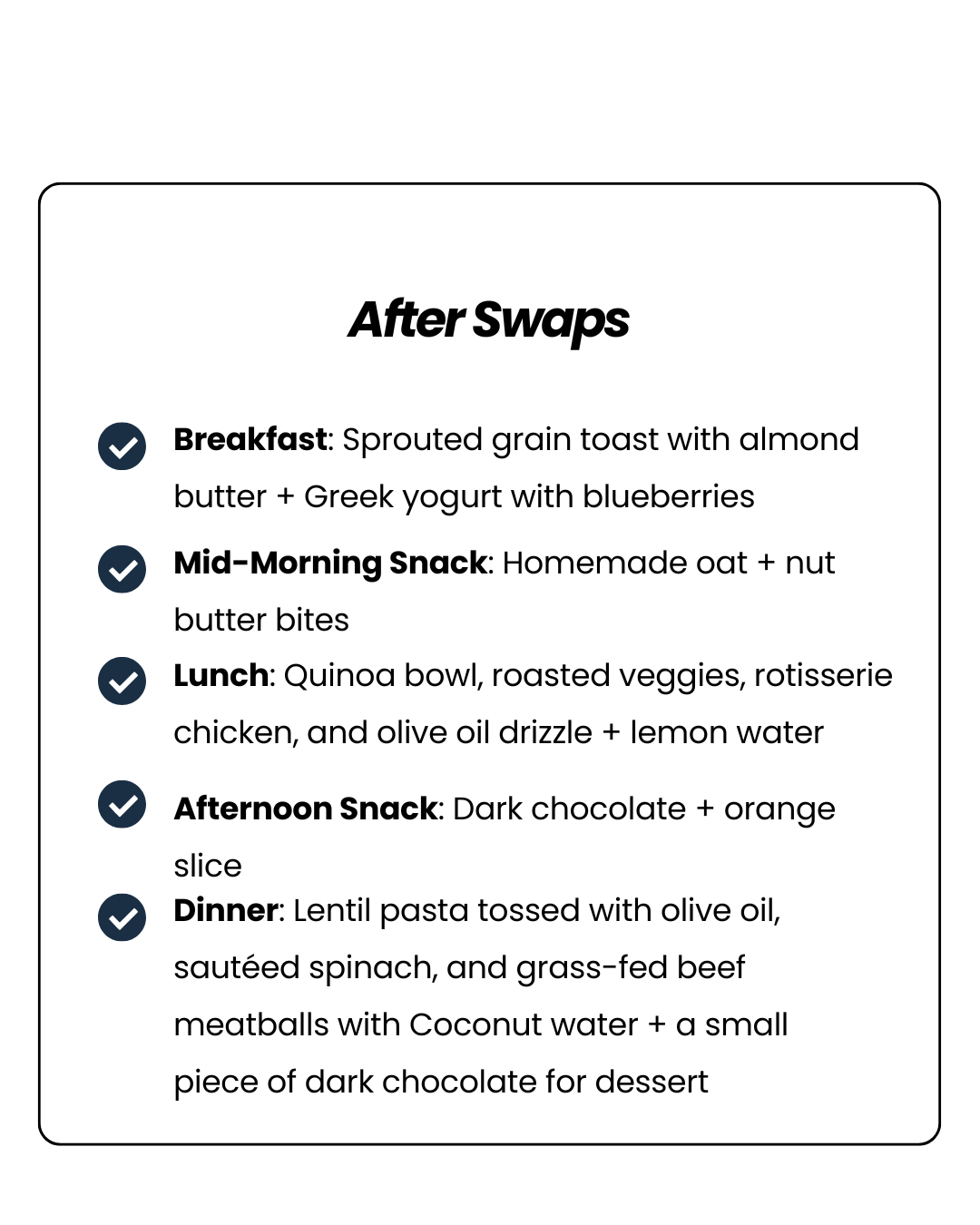10 Smart Food Swaps for Runners to Boost Recovery
One of the most important truths I share with runners is this: every bite of food you eat sends a message to your body. That message can either delay recovery—or help you bounce back stronger.
When your diet leans heavily on refined carbs, added sugars, processed foods, or nutrient-poor foods, your body has to work harder to repair muscle tissue, restore glycogen, and calm inflammation after training. Over time, that can mean more soreness, slower recovery, and even nagging injuries.
The good news? Food can also be your most powerful recovery tool. By making simple swaps, you can trade in foods that drag you down for nutrient-rich options that help you refuel smarter, reduce inflammation, and keep your legs feeling fresh.
10 Simple Food Swaps for Better Recovery
1. White Pasta → Lentil or Chickpea Pasta
White pasta provides quick carbs but little else. Lentil or chickpea pasta delivers complex carbs plus 12–15 grams of protein per serving, which helps stimulate muscle protein synthesis. The added fiber slows digestion just enough to keep blood sugar stable, making it a smarter choice for post-run dinners.
2. Flavored Yogurt → Greek Yogurt + Berries
Most flavored yogurts pack as much sugar as dessert. Greek yogurt with berries adds 15–20 grams of high-quality protein and probiotics for gut health. The berries bring antioxidants like anthocyanins that reduce post-run muscle soreness and oxidative stress.
3. Sports Drinks Loaded with Dye + Corn Syrup → Coconut Water + Pinch of Sea Salt
Commercial sports drinks often deliver a blood sugar spike and gut distress. Coconut water naturally contains potassium, magnesium, and sodium—the electrolytes runners actually sweat out. Adding a pinch of sea salt rounds out the electrolytes you need like sodium and magnesium.
4. Protein Bars with Long Ingredient Lists → Homemade Oat + Nut Butter Bites
Packaged bars can be loaded with sugar and fillers that upset digestion. Oats and nut butter create a better carb + fat combo that provides steady energy and faster glycogen replacement. Toss in seeds, pumpkin, yams or protein powder to tailor them to your training and flavour needs.
5. White Bagels → Sprouted Grain or Sourdough Bread
Bagels are carb bombs that can be great for pre-run fuelling, but are less optimal for recovery. Sprouted grain or sourdough offers the same carb boost but with added minerals, B vitamins, and easier digestibility. For runners prone to blood sugar dips, adding in some protein and fat (for example, salmon and cream cheese) to this swap keeps energy more stable while still replenishing glycogen.
6. Processed Deli Meats → Smoked Salmon or Rotisserie Chicken
Deli meats are often high in sodium, nitrates, and low-quality protein. Smoked salmon provides omega-3s that actively reduce inflammation, while rotisserie chicken is a quick, clean source of lean protein to rebuild muscle tissue after runs. Both are runner-friendly grab-and-go options.
7. Candy or Sugary Desserts → Dark Chocolate + Fruit
If you’re looking for a better alternative to a dessert, try dark chocolate paired with fruit to provide natural carbs for glycogen recovery plus antioxidants like flavonoids and vitamin C that support connective tissue repair. It satisfies the sweet tooth while boosting recovery.
8. Deep Fried Takeout → Grain Bowls with Roasted Veg + Lean Protein
Fried foods are often cooked in oils that promote inflammation and can hinder recovery. Grain bowls built with quinoa, roasted veggies, and lean protein offer the right carb-to-protein ratio for muscle repair and the phytonutrients that speed healing. A drizzle of olive oil adds healthy fats for long-term joint health.
9. Conventional Beef → Grass-Fed Beef or Pasture-Raised Chicken
Conventionally raised meat often contains more omega-6 fats, which can promote inflammation. Grass-fed beef or pasture-raised chicken have higher omega-3s, more antioxidants like vitamin E, and better amino acid profiles (what are needed to build muscle). That means your muscles get the building blocks they need without the extra inflammatory load.
10. Soda or Energy Drinks → Sparkling Water with Citrus or Green Tea
Sodas and energy drinks dehydrate more than they help, thanks to excess sugar and stimulants. Sparkling water with citrus is hydrating and refreshing, while green tea adds a natural caffeine boost and antioxidants that reduce exercise-induced oxidative stress. Both options support steady energy instead of the dreaded crash.
Example Day: Before vs. After Food Swaps
Sometimes the best way to see the power of these swaps is side-by-side. Here’s how a typical training day might look before and after making better choices for recovery:
Before Macros (approx):
Carbs: 380g
Protein: 65g
Fat: 110g
High sugar, low fiber, and low-quality protein = sluggish recovery and more inflammation.
After Macros (approx):
Carbs: 340g
Protein: 120g
Fat: 80g
Enough carbs to restore glycogen, higher-quality protein for muscle repair, and healthy fats + antioxidants to calm inflammation.
👉 Notice the difference? The “After” day doesn’t sacrifice carbs (as runners, you still need them!) but balances them with quality protein, anti-inflammatory fats, and nutrient-dense foods that actually support training adaptations instead of holding them back.
Final Thoughts
Recovery doesn’t start with fancy supplements—it starts with the fuel you give your body every single day. By making thoughtful swaps, you give your muscles the raw materials they need to repair, adapt, and carry you farther.
✨ Ready to run stronger? I help female endurance athletes create personalized recovery and fueling strategies so they can train hard and still feel amazing off the road. Book a free discovery call today to see how food can become your most powerful recovery tool.


